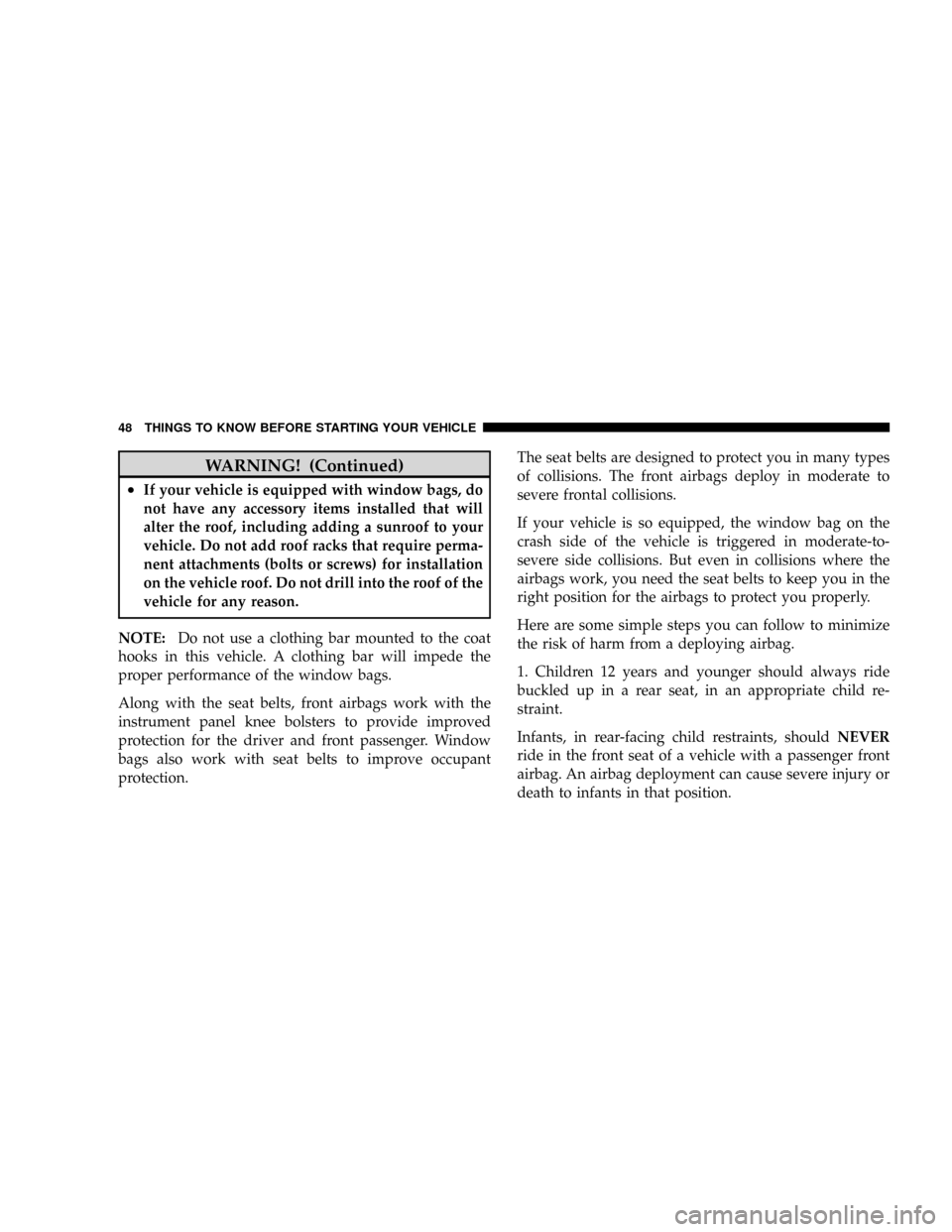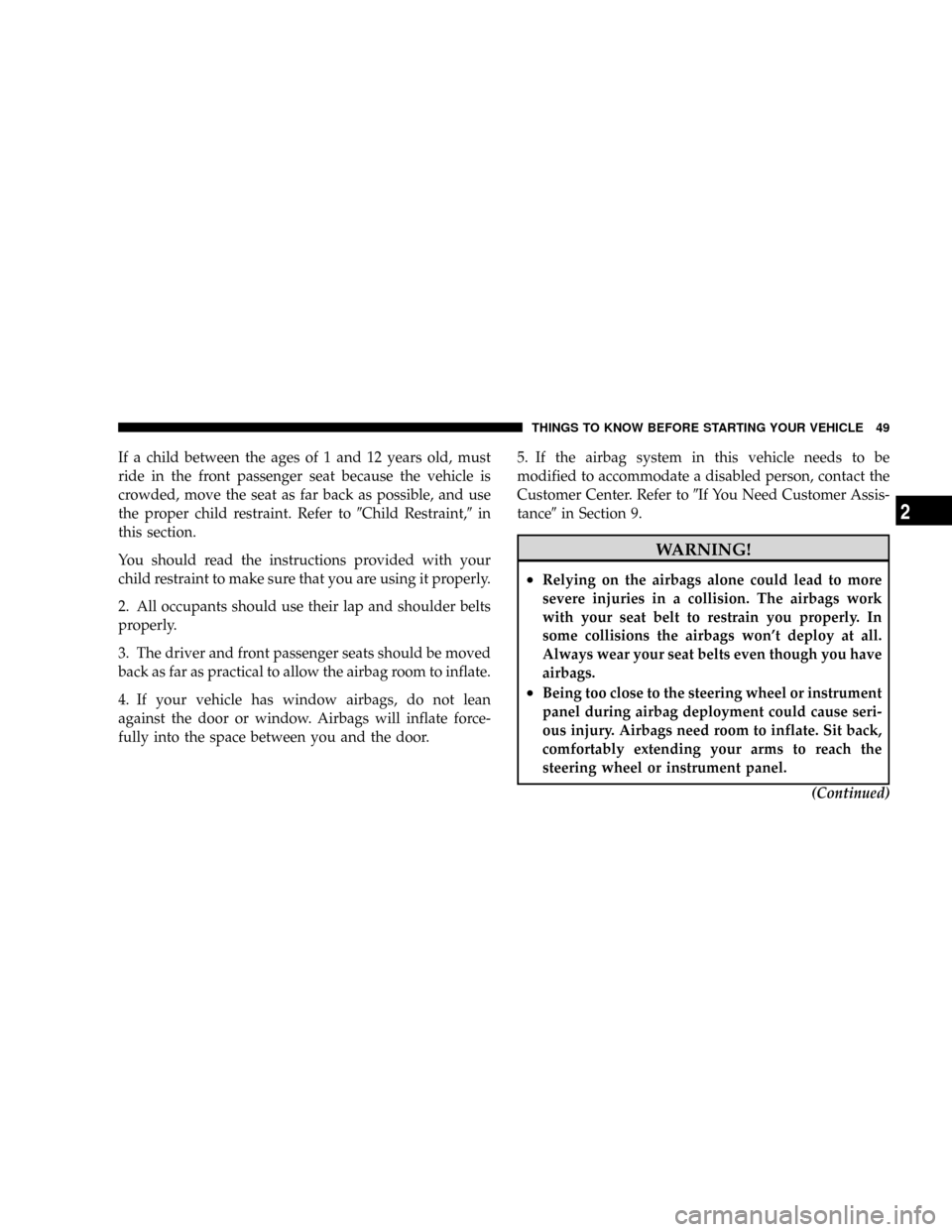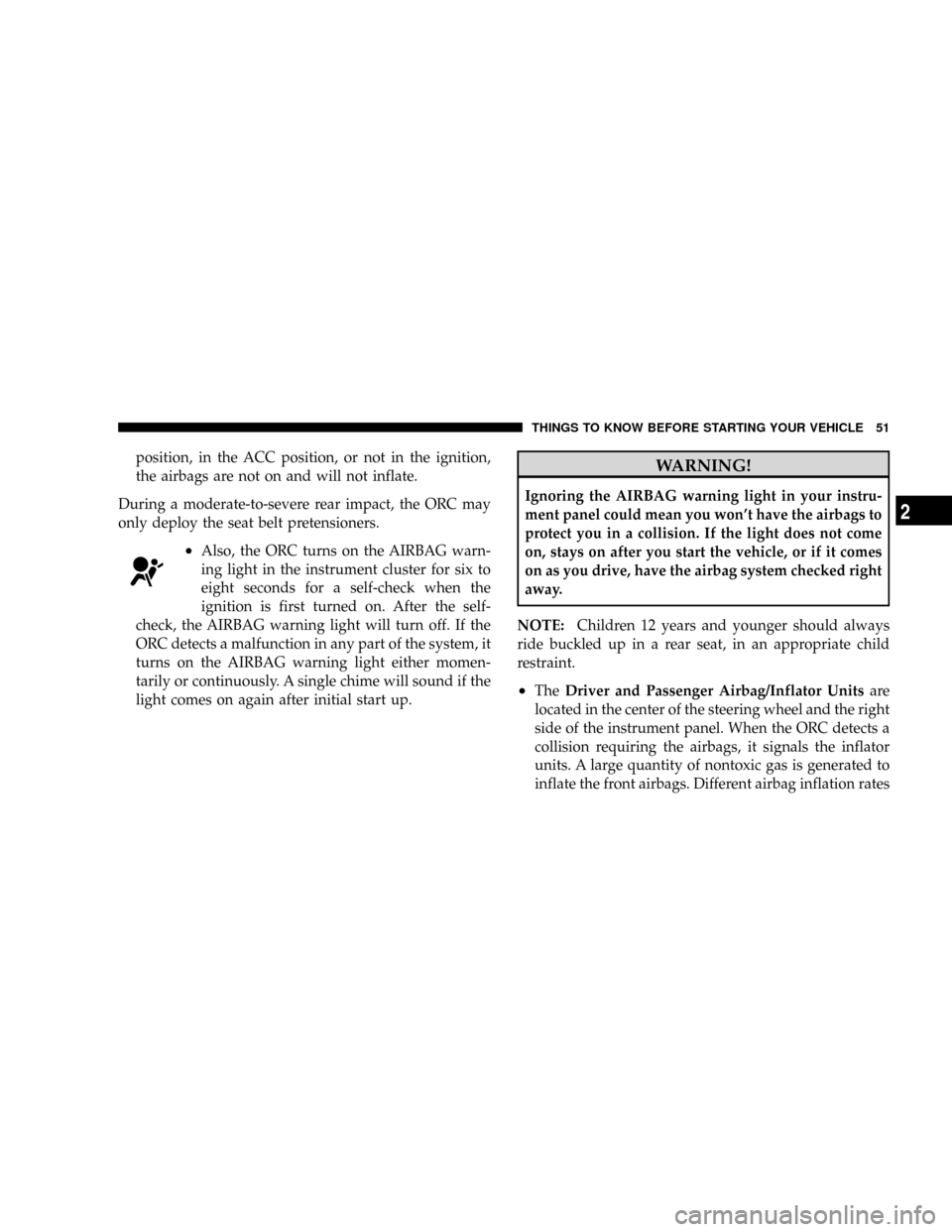Page 3 of 449
TABLE OF CONTENTSSECTIONPAGE
1INTRODUCTION.............................................................3
2THINGS TO KNOW BEFORE STARTING YOUR VEHICLE...............................9
3UNDERSTANDING THE FEATURES OF YOUR VEHICLE...............................75
4UNDERSTANDING YOUR INSTRUMENT PANEL................................... 163
5STARTING AND OPERATING................................................. 235
6WHAT TO DO IN EMERGENCIES...............................................331
7MAINTAINING YOUR VEHICLE............................................... 349
8MAINTENANCE SCHEDULES.................................................. 399
9IF YOU NEED CONSUMER ASSISTANCE..........................................417
10INDEX....................................................................427
1
2
3
4
5
6
7
8
9
10
Page 8 of 449
WARNINGS AND CAUTIONS
This Owner's Manual containsWARNINGSagainst op-
erating procedures that could result in an accident or
bodily injury. It also containsCAUTIONSagainst proce-
dures that could result in damage to your vehicle. If you
do not read this entire manual, you may miss important
information. Observe all Warnings and Cautions.
VEHICLE IDENTIFICATION NUMBER
The Vehicle Identification Number (VIN) is located on
the left front corner of the instrument panel pad, visible
from outside of the vehicle through the windshield. This
number also appears on the Automobile Information
Disclosure Label affixed to a window on your vehicle.
Save this label for a convenient record of your vehicle
identification number and optional equipment.NOTE:It is illegal to remove the VIN.
VIN Location
6 INTRODUCTION
Page 16 of 449
CAUTION!
An unlocked car is an invitation to thieves. Always
remove the key from the ignition and lock all the
doors when leaving the vehicle unattended.
Manual Transmission Ð If Equipped
When the steering wheel is in the LOCK position, the
steering and ignition systems are locked to provide
antitheft protection for your vehicle. It may be difficult to
turn the key from the LOCK position when starting your
vehicle. Move the steering wheel left and right while
turning the key until it turns easily. To remove the key,
depress and hold the release button located between the
ignition switch and the instrument panel. Turn the igni-
tion key to LOCK and remove the key.
Ignition Release Button
1 Ð ACC 4 Ð ON/RUN
2 Ð LOCK 5 Ð START
3 Ð OFF 14 THINGS TO KNOW BEFORE STARTING YOUR VEHICLE
Page 48 of 449
WARNING!
Using a seat belt extender when not needed can
increase the risk of injury in a collision. Only use the
seat belt extender when the lap belt is not long
enough when it is worn low and snug, and in the
recommended seating positions. Remove and store
the extender when not needed.
Driver And Right Front Passenger Supplemental
Restraint System (SRS) ± Airbags
This vehicle has airbags for both the driver and right
front passenger as a supplement to the seat belt restraint
systems. The driver's front airbag is mounted in the
steering wheel. The passenger's front airbag is mounted
in the instrument panel, above the glove compartment.
The words SRS/AIRBAG are embossed on the airbag
covers.NOTE:The front airbags are certified to the Federal
regulations that allow less forceful deployment.
1 Ð Airbags
2 Ð Knee Bolsters 46 THINGS TO KNOW BEFORE STARTING YOUR VEHICLE
Page 50 of 449

WARNING! (Continued)
²If your vehicle is equipped with window bags, do
not have any accessory items installed that will
alter the roof, including adding a sunroof to your
vehicle. Do not add roof racks that require perma-
nent attachments (bolts or screws) for installation
on the vehicle roof. Do not drill into the roof of the
vehicle for any reason.
NOTE:Do not use a clothing bar mounted to the coat
hooks in this vehicle. A clothing bar will impede the
proper performance of the window bags.
Along with the seat belts, front airbags work with the
instrument panel knee bolsters to provide improved
protection for the driver and front passenger. Window
bags also work with seat belts to improve occupant
protection.The seat belts are designed to protect you in many types
of collisions. The front airbags deploy in moderate to
severe frontal collisions.
If your vehicle is so equipped, the window bag on the
crash side of the vehicle is triggered in moderate-to-
severe side collisions. But even in collisions where the
airbags work, you need the seat belts to keep you in the
right position for the airbags to protect you properly.
Here are some simple steps you can follow to minimize
the risk of harm from a deploying airbag.
1. Children 12 years and younger should always ride
buckled up in a rear seat, in an appropriate child re-
straint.
Infants, in rear-facing child restraints, shouldNEVER
ride in the front seat of a vehicle with a passenger front
airbag. An airbag deployment can cause severe injury or
death to infants in that position.
48 THINGS TO KNOW BEFORE STARTING YOUR VEHICLE
Page 51 of 449

If a child between the ages of 1 and 12 years old, must
ride in the front passenger seat because the vehicle is
crowded, move the seat as far back as possible, and use
the proper child restraint. Refer to9Child Restraint,9in
this section.
You should read the instructions provided with your
child restraint to make sure that you are using it properly.
2. All occupants should use their lap and shoulder belts
properly.
3. The driver and front passenger seats should be moved
back as far as practical to allow the airbag room to inflate.
4. If your vehicle has window airbags, do not lean
against the door or window. Airbags will inflate force-
fully into the space between you and the door.5. If the airbag system in this vehicle needs to be
modified to accommodate a disabled person, contact the
Customer Center. Refer to9If You Need Customer Assis-
tance9in Section 9.
WARNING!
²Relying on the airbags alone could lead to more
severe injuries in a collision. The airbags work
with your seat belt to restrain you properly. In
some collisions the airbags won't deploy at all.
Always wear your seat belts even though you have
airbags.
²Being too close to the steering wheel or instrument
panel during airbag deployment could cause seri-
ous injury. Airbags need room to inflate. Sit back,
comfortably extending your arms to reach the
steering wheel or instrument panel.
(Continued)
THINGS TO KNOW BEFORE STARTING YOUR VEHICLE 49
2
Page 52 of 449

WARNING! (Continued)
²If the vehicle has window bags, they also need
room to inflate. Do not lean against the door or
window. Sit upright in the center of the seat.
Airbag System Components
The airbag system consists of the following:
²Occupant Restraint Controller
²Side Remote Acceleration Sensors ± if equipped
²Airbag Warning Light
²Driver Airbag
²Passenger Airbag
²Window Bags above side windows ± if equipped
²Steering Wheel and Column
²Instrument Panel
²Interconnecting Wiring
²Knee Impact Bolsters
²Front Acceleration Sensors
²Driver and Front Passenger Seat Belt Pretensioners
How the Airbag System Works
²
TheOccupant Restraint Controller (ORC)determines
if a frontal collision is severe enough to require the
airbags to inflate. The front airbag inflators are de-
signed to provide different rates of airbag inflation
from direction provided by the ORC. The ORC will not
detect rollover.
The ORC also monitors the readiness of the electronic
parts of the system whenever the ignition switch is in
the START or RUN position. These include all of the
items listed above, except the steering wheel and
column, and knee bolsters. If the key is in the OFF
50 THINGS TO KNOW BEFORE STARTING YOUR VEHICLE
Page 53 of 449

position, in the ACC position, or not in the ignition,
the airbags are not on and will not inflate.
During a moderate-to-severe rear impact, the ORC may
only deploy the seat belt pretensioners.
²Also, the ORC turns on the AIRBAG warn-
ing light in the instrument cluster for six to
eight seconds for a self-check when the
ignition is first turned on. After the self-
check, the AIRBAG warning light will turn off. If the
ORC detects a malfunction in any part of the system, it
turns on the AIRBAG warning light either momen-
tarily or continuously. A single chime will sound if the
light comes on again after initial start up.
WARNING!
Ignoring the AIRBAG warning light in your instru-
ment panel could mean you won't have the airbags to
protect you in a collision. If the light does not come
on, stays on after you start the vehicle, or if it comes
on as you drive, have the airbag system checked right
away.
NOTE:Children 12 years and younger should always
ride buckled up in a rear seat, in an appropriate child
restraint.
²TheDriver and Passenger Airbag/Inflator Unitsare
located in the center of the steering wheel and the right
side of the instrument panel. When the ORC detects a
collision requiring the airbags, it signals the inflator
units. A large quantity of nontoxic gas is generated to
inflate the front airbags. Different airbag inflation rates
THINGS TO KNOW BEFORE STARTING YOUR VEHICLE 51
2